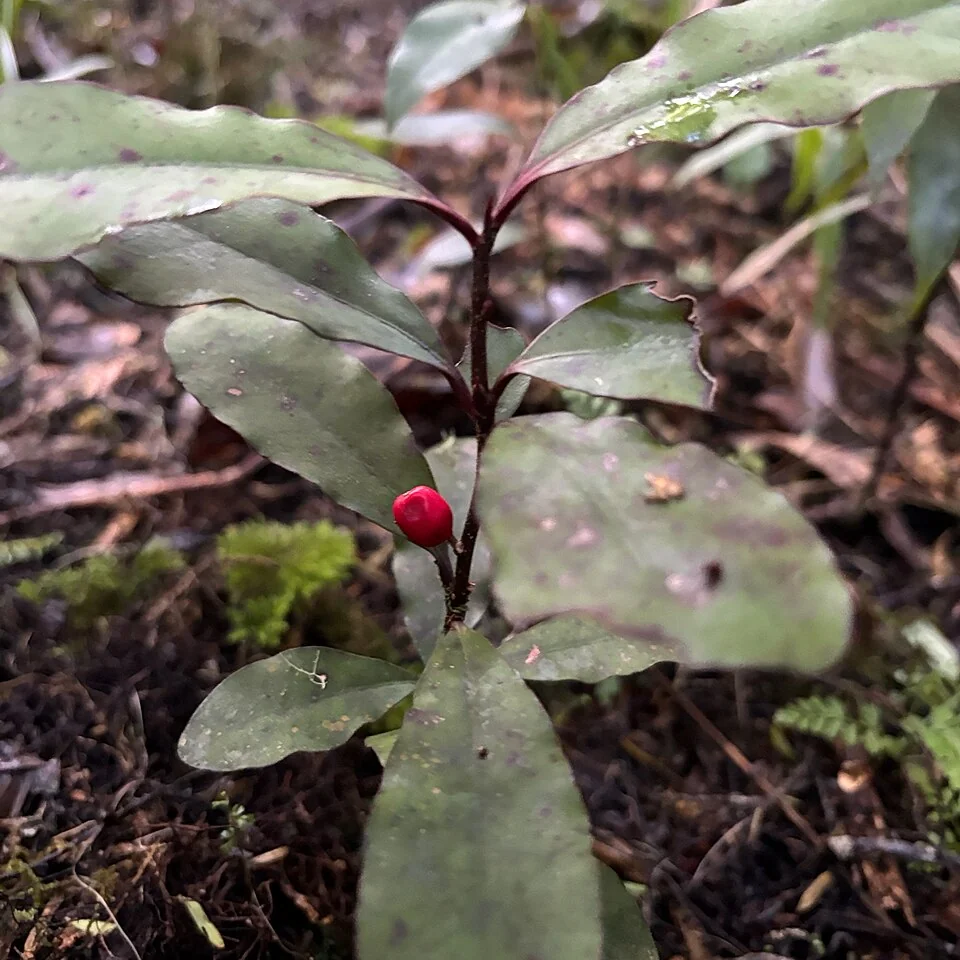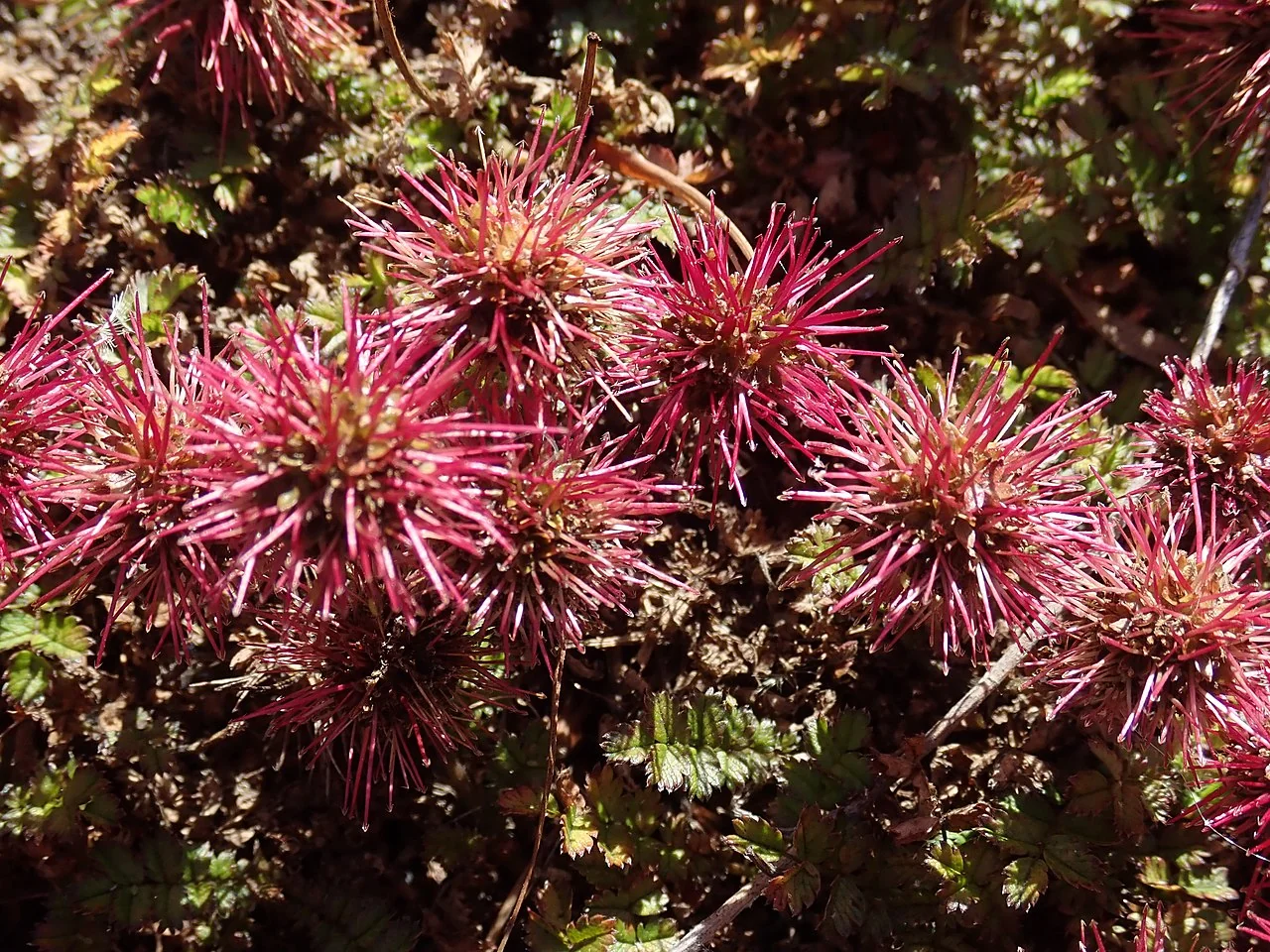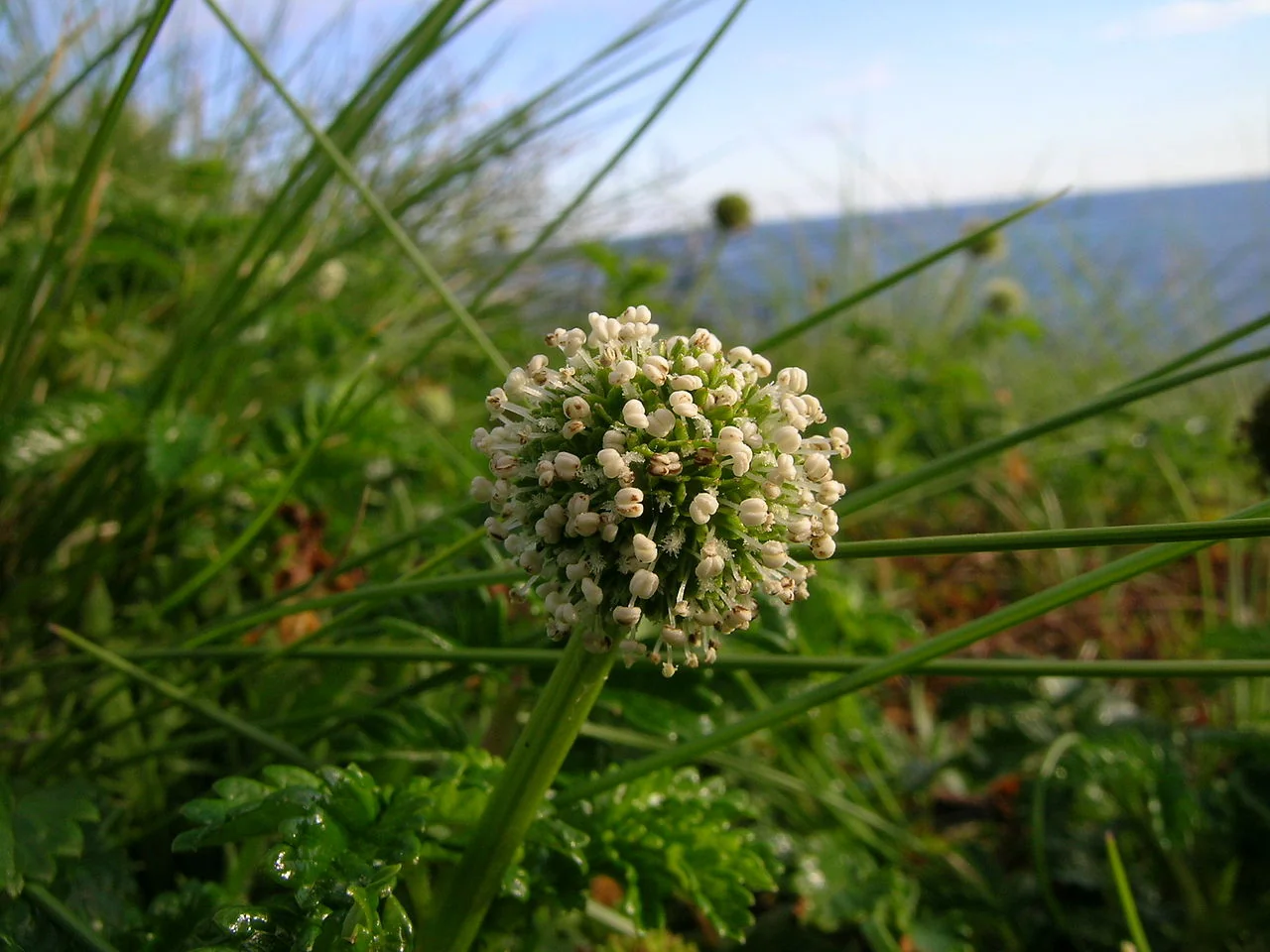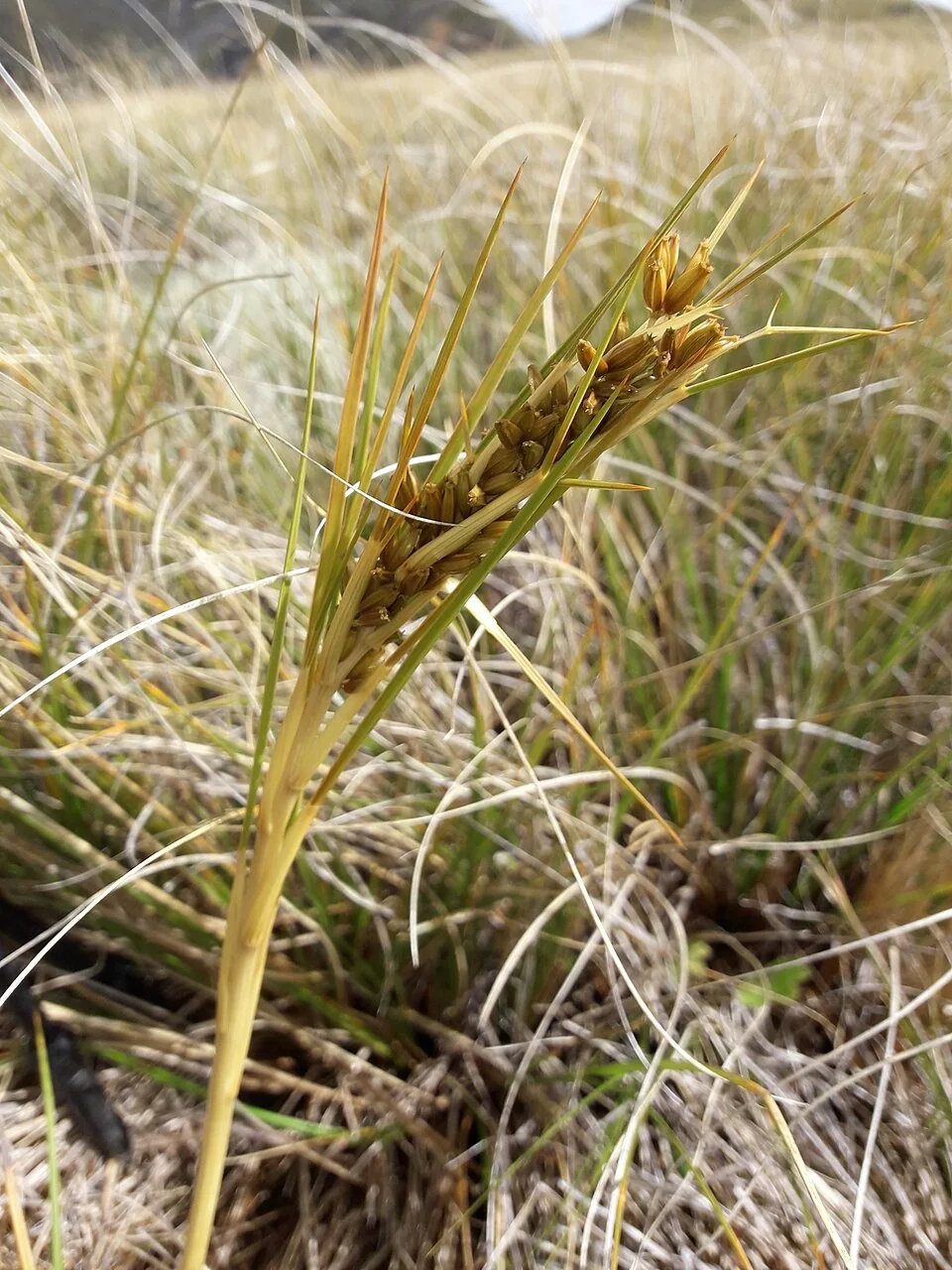
Large-Leaved Toropapa
Alseuosmia macrophylla
Explore more NZ native plant guides in our index .
Introduction
Fragrant Forest Shrub
Alseuosmia macrophylla , also known as large-leaved toropapa or karapāpā, is a small, evergreen shrub native to the understory of New Zealand's forests. It is prized for its glossy, dark green leaves and intensely fragrant, crimson flowers that bloom in spring. The scent of the flowers is often compared to that of daphne or carnations.

Plant Description
Physical Characteristics
Alseuosmia macrophylla is a captivating evergreen shrub, typically growing to a height of 1-2 meters with a similar spread. Its most striking features are its large, glossy, dark green leaves, which are ovate to elliptic in shape, often with a prominent midrib and wavy margins. The leaves are arranged alternately along the stems and can reach up to 15 cm in length, providing a lush, tropical appearance.
The plant is particularly renowned for its highly fragrant flowers, which emerge in clusters from the leaf axils or directly from the stems in spring. These tubular flowers are typically crimson to dark red, though variations in pink or white can occur. Each flower is relatively small, about 1-2 cm long, but their collective scent is powerful and sweet, often described as clove-like or reminiscent of daphne. The fragrance is most potent in the evening, attracting nocturnal pollinators.
Following successful pollination, the flowers give way to small, fleshy berries, usually red or orange, which ripen in late summer to autumn. These berries contain the seeds and are a food source for native birds, aiding in seed dispersal. The overall form of the shrub is often open and somewhat sprawling, making it an attractive understory plant in its natural forest habitat.
Quick Facts
Plant Summary
| Scientific Name | Alseuosmia Macrophylla |
|---|---|
| Height | 1-2 m |
| Spread | 1-1.5 m |
| Water Needs | Moderate; prefers moist, well-drained soil |
| Light | Partial to full shade |
| Frost Tolerance | Moderate |
| Salt Tolerance | Low |
| Growth Rate | Slow |
| Lifespan | Perennial |
Climate Best Suited to
Alseuosmia macrophylla is found in lowland to montane forests throughout the North Island and in the northern South Island. It prefers a mild, humid climate with regular rainfall.
Regional Suitability
| Whangārei | Ideal |
| Auckland | Ideal |
| Hamilton | Suitable |
| Rotorua | Suitable |
| Tauranga | Ideal |
| Gisborne | Ideal |
| New Plymouth | Ideal |
| Whanganui | Ideal |
| Palmerston North | Suitable |
| Napier | Ideal |
| Wellington | Ideal |
| Nelson | Ideal |
| Christchurch | Suitable |
| Dunedin | Suitable |
| Invercargill | Suitable |
| City | Climate Suitability |
|---|
Natural Habitat
Typical Environments
Alseuosmia macrophylla is endemic to New Zealand, primarily found in the North Island and the northern parts of the South Island. It thrives in the understory of lowland to montane forests, typically in damp, shaded, and sheltered locations. This species is a classic example of a forest understory shrub, preferring the cool, humid conditions found beneath a dense canopy of larger trees.
Its preferred habitats include:
- Forest Understory: Growing beneath broadleaf and podocarp forests, where it receives dappled light and protection from strong winds and direct sun.
- Gullies and Stream Banks: Often found in moist, sheltered gullies and along the banks of streams, where humidity levels are consistently high.
- Humus-rich Soils: It prefers well-drained, but consistently moist, acidic soils rich in organic matter, typical of mature forest floors.
The presence of Alseuosmia macrophylla often indicates a healthy, undisturbed forest ecosystem with good moisture retention and a stable microclimate. Its sensitivity to direct sun and drought makes it a good indicator of forest health.
Plant Conservation
Threats and Efforts
While Alseuosmia macrophylla is currently classified as "Not Threatened" nationally, its populations face ongoing challenges. The primary threats include habitat degradation and browsing by introduced mammalian pests such as possums, deer, and goats, which can significantly impact plant health and regeneration. Additionally, the species relies on specific native birds for effective pollination and seed dispersal, and declines in these bird populations can affect the plant's reproductive success.
Conservation efforts focus on protecting existing forest habitats where Alseuosmia macrophylla thrives, particularly through pest control programs to manage introduced browsers. Research into its specific ecological requirements, including its mycorrhizal associations and pollination biology, is also important for effective conservation. Propagation and planting in suitable restoration projects help to bolster populations and ensure the long-term survival of this fragrant native shrub.
Growing Requirements
Soil Requirements
Prefers a moist, well-drained, humus-rich soil.
Light Requirements
Thrives in partial to full shade. It will not tolerate direct sun.
Water Requirements
Requires regular watering, especially during dry periods.
Planting Guide
-
When to Plant
Plant in autumn or spring.
-
Site Preparation
Choose a shady site with moist, well-drained soil.
-
Planting and Aftercare
Dig a hole twice the width of the pot. Place the plant in the hole and backfill with soil. Water well and apply a layer of mulch.
Ecological Significance
Broader Ecological Importance
The ecological significance of Alseuosmia macrophylla extends beyond its immediate role in the forest understory. As an endemic species, it contributes to the unique biodiversity of New Zealand's native forests. Its presence is often indicative of a healthy and mature forest ecosystem, particularly those with a well-developed understory and consistent humidity.
The plant's fragrant flowers, while beautiful to humans, are primarily an adaptation to attract specific pollinators. This specialized interaction between the plant and its pollinators is a key component of forest ecosystem function, contributing to the genetic diversity and health of both the plant and insect populations.
The berries of Alseuosmia macrophylla provide a valuable food source for native birds, which are crucial for seed dispersal. This mutualistic relationship ensures the regeneration and spread of the plant, contributing to the overall resilience and continuity of the forest.
Furthermore, as a shade-loving understory plant, Alseuosmia macrophylla helps to maintain the microclimate of the forest floor, contributing to soil moisture retention and nutrient cycling. Its sensitivity to environmental changes, particularly to habitat disturbance and the impacts of introduced pests, makes it a valuable indicator species for monitoring the health of New Zealand's native forests. Protecting this species, therefore, contributes to the broader conservation of these unique and vital ecosystems.
Uses and Significance
Garden Uses
- An excellent plant for shady borders, woodland gardens, and containers.
- It is also a good choice for planting under large trees.
Cultural Significance
Traditional Uses and Values
The intense fragrance of the flowers was highly prized by Māori, who would often wear them as a perfume. The flowers were also used to scent homes and meeting houses. The name 'Alseuosmia' is derived from the Greek words for 'grove' and 'scent', referring to the plant's powerful fragrance.
Landscaping with Large-Leaved Toropapa
Design and Placement
Alseuosmia macrophylla is an exceptional choice for landscaping in shaded, sheltered areas, particularly in gardens aiming for a native New Zealand forest aesthetic. Its glossy foliage and intensely fragrant flowers make it a valuable addition to various garden designs:
- Forest Underplanting: Ideal for planting beneath established trees or in woodland gardens, where it can thrive in the dappled light and rich, moist soil conditions. It pairs well with other shade-loving native plants like ferns, astelias, and other understory shrubs.
- Shady Borders and Hedges: Its compact size and attractive foliage make it suitable for creating low, informal hedges or as a specimen plant in shaded borders. The fragrance will be particularly appreciated near pathways or seating areas.
- Container Planting: Can be grown in large containers in shaded courtyards or balconies, allowing its delicate beauty and scent to be enjoyed up close. Ensure containers have good drainage and use a high-quality, humus-rich potting mix.
- Sensory Gardens: Due to its strong, sweet fragrance, it is an excellent addition to sensory gardens, providing an olfactory delight, especially during its spring flowering period.
- Restoration Planting: In suitable ecological contexts, it can be used in restoration projects to re-establish native understory vegetation in degraded forest areas.
When designing with Alseuosmia macrophylla , remember its need for consistent moisture and protection from direct sun and strong winds. Grouping it with other plants that share similar requirements will ensure its success and enhance the overall health of your garden.
Seasonal Care Calendar
Spring
- Apply a layer of mulch to help retain moisture.
Summer
- Water regularly.
Autumn
- No special care required.
Winter
- Protect from heavy frosts.
Pruning
Maintenance
Pruning is rarely required for Toropapa. You may lightly trim it after flowering to maintain a compact shape, but its natural habit is quite neat. Remove any dead or damaged wood as soon as it appears to keep the shrub healthy.
How to Grow Large-Leaved Toropapa
Cuttings
Semi-hardwood cutting propagation offers moderate success rates for Large-leaved Toropapa, though results can be variable and patience is essential. Take cuttings during summer when new growth is beginning to firm up but not fully hardened, selecting healthy shoots 8-12cm long from vigorous, disease-free plants. Choose material from the current season's growth, making clean cuts just below a node with sharp, sterile secateurs. Remove the lower leaves while retaining 2-3 pairs at the tip, and treat the cut end with a strong rooting hormone containing both auxins and fungicides to improve success rates. Insert cuttings into a well-draining propagation mix of equal parts peat moss and perlite, ensuring good contact between the cutting and growing medium. Provide high humidity through misting systems or clear plastic covers, maintaining temperatures around 18-22°C with bright, indirect light. This species is notably slow to root, typically requiring 5-8 weeks for initial root development, though some cuttings may take several months to establish fully. Monitor closely for fungal issues in the humid environment and provide good air circulation to prevent problems. Once roots are well-developed, gradually acclimatize young plants to ambient conditions over several weeks before transplanting to individual containers.
Seeds
Seed propagation of Large-leaved Toropapa is challenging and requires specific conditions for success, with germination often being slow and erratic. Fresh seeds are essential as viability decreases rapidly with storage, and they should be collected from ripe berries in late summer to autumn. Remove all fruit pulp thoroughly before sowing, as residual fruit material can inhibit germination and promote fungal growth. The most critical factor for successful seedling establishment is the presence of mycorrhizal fungi, which form essential symbiotic relationships with the plant roots. When sowing, incorporate soil inoculum from around healthy, established forest specimens of Alseuosmia or related species to introduce beneficial fungi. Without this mycorrhizal partnership, seedlings often germinate successfully but fail to thrive, typically dying at the cotyledon stage despite appearing initially healthy. Sow seeds in autumn just below the surface of a well-draining, sterile growing medium, maintaining consistent moisture without waterlogging. Germination can be extremely slow and irregular, with some seeds not sprouting until late in the following year or even longer. Avoid using artificial heat during germination as this can induce deeper dormancy. Provide protection from temperature extremes and maintain patience, as this species' natural regeneration strategy involves slow, steady establishment rather than rapid growth.
Layering
Layering is a highly effective propagation method for Large-leaved Toropapa, taking advantage of the plant's natural tendency to layer readily when branches come into contact with suitable growing medium. This method is particularly valuable given the challenges associated with seed germination and variable success with cuttings. Ground layering can be performed during spring or early summer when the plant is actively growing. Select a flexible, low-growing branch and gently wound the bark where it will contact the soil, creating a small scratch or removing a narrow ring of bark to encourage root formation. Pin the wounded section to the ground using wire pegs or small stones, ensuring good contact with moist, humus-rich soil while leaving the growing tip exposed and supported. Cover the layered section with a mixture of compost and native soil, maintaining consistent moisture throughout the rooting period. Root development typically occurs within 6-12 months, though some layers may take longer to establish fully. Air layering is also possible for higher branches, wrapping the wounded area with moist sphagnum moss and plastic film to create optimal rooting conditions. Once a strong root system has developed, carefully sever the new plant from the parent and transplant during mild weather, providing shelter and consistent moisture during establishment. This method produces plants identical to the parent and often has higher success rates than other propagation techniques for this species.
Pests and Diseases
Common Pests
- Aphids: These small, sap-sucking insects can be observed on new growth, potentially causing leaf distortion and stunted development.
- Browsing Animals: Possums, deer, goats, and even pigs are known to browse on Alseuosmia macrophylla , causing significant damage to foliage and young stems.
- Slugs and Snails: Can cause leaf damage, especially to young plants or tender new shoots in moist conditions.
Potential Issues
- Sudden Collapse: Alseuosmia macrophylla is highly sensitive to dry conditions and can suffer sudden collapse during prolonged dry spells. Consistent moisture is crucial for its health.
- Fungal Diseases: While generally resistant, poor air circulation or overly wet conditions can lead to fungal issues like leaf spot or root rot. Ensure good drainage and adequate spacing.
Maintaining optimal growing conditions, particularly consistent moisture and appropriate shade, is key to preventing most pest and disease problems for this species.
Bonus Tip
Enhancing Fragrance in Your Garden
To fully appreciate the exquisite fragrance of Alseuosmia macrophylla , consider planting it near a seating area, a frequently used pathway, or close to a window. The scent is most potent in the evening, so placing it where you can enjoy it during cooler parts of the day or night will maximize its impact.
For an even more immersive experience, plant several specimens together to create a fragrant grove. The collective scent will be more pronounced and create a truly enchanting atmosphere in your garden. Remember its preference for shade and consistent moisture when choosing its location to ensure it thrives and rewards you with its beautiful aroma.







